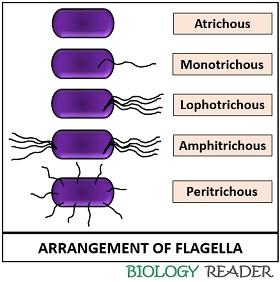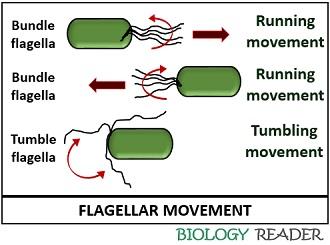Bacterial flagella refer to the locomotory apparatuses, which help the bacteria to swim in the liquid nutrient medium. The bacteria possessing flagella are the motile organisms or flagellates. Conversely, the non-motile organisms or non-flagellates lack flagella.
The width of bacterial flagella is much thinner and simpler than the eukaryotic flagella. The location, number and arrangement of flagella vary considerably in different bacterial species. A basic structure of flagella possess three domains, namely hook, basal body and filament.
Bacterial flagella lack a “9+2” arrangement of microtubules. The presence or absence of flagella or to detect motility, we can perform flagella staining by using special flagellar stains.
In this post, we will discuss the definition, features and all the structural components of the bacterial flagella. In addition, types, functions, the meaning of bacterial motility and polymorphic transitions have been explained.
Content: Bacterial Flagella
- Definition
- Features
- Structure
- Flagella Types
- Functions
- Bacterial Motility
- Polymorphic Transitions
- Conclusion
Definition of Bacterial Flagella
Bacterial flagella refer to the twisted hair-like filaments that impose swimming motility in some groups of bacteria. The one end of the flagellar apparatus protrudes from a bacterial cell surface, and the other portion remains free for the locomotary functions.
These structures are too thin, and it is difficult for us to determine bacterial motility. Thus, we need to examine the cells under a light microscope after performing flagella staining using special stains. Flagella are abundantly found in gram-negative rods and a few gram-positive rods and cocci.
Features
- Flagella in prokaryotes are the proteinaceous structures that possess protein monomers or flagellins.
- Inside the flagella, the flagellin subunits are organized in a helical fashion.
- Flagella exist as the protrusions of the bacterial cell, which perform a significant role in locomotion.
- Other than locomotion, flagella also regulate sensory functions in prokaryotes by sensing temperature and chemical variations.
- The function of flagella is to provide motility in both bacteria and multicellular organisms. But, its morphology, chemical composition and propulsion mechanism differ in both types.
- The flagellar distribution helps distinguish or classify the bacteria, and the distribution can be polar or lateral.
- Polar flagella is a type of arrangement where the flagellar appendages protrude from one or both ends of the bacterial cell surface.
- Lateral flagella is a type of arrangement where the flagellar appendages exist over the full bacterial cell surface.
- It may also function as “Secretory organelles”.
Structure of Bacterial Flagella
Three structural elements constitute the formation of the flagellar apparatus.

Basal Body
It is generally attached to the cell wall and cell membrane and embedded with the rack of rings arranged one over the other. The rings possess protein sub-units. It typically comprises M, S, P and L rings.
M and S rings are associated with the cytoplasmic membrane, while P and L rings are associated with the periplasmic space and cell wall.
The protein rings serve to pump protons or H+ ions across the membrane and facilitate ATP generation. The bacterial cell harnesses ATP (Adenosine triphosphate) to rotate the rings as well as the filament.
A pair of proteins, i.e. “Mot” and “Fli”, encircle the four rings. Mot protein causes motor rotation. Oppositely, the Fli protein functions as a motor switch that reverses the flagellar rotation in response to the intracellular signals. Also, the basal body anchors the filament of the flagellum.
Hook
It is the broader region present at the flagellum base. Hook performs a key role in connecting filament to the motor region or basal body. Its length is greater in gram-positive bacterial strains.
About 120 sub-units of a single protein constitute the formation of a short and curved hook. Hook remains free or dissociated with the structures like cell wall and plasma membrane.
It promotes the taxis and motility of the bacteria by generating a motor torque to the filament. It comprises a pair of protein, namely FlgK and FlgL, that helps in connecting the filament and its synthesis.
Filament
It appears like a whip-like structure. Filament seems long, coiled, thin, and several times bigger than the whole bacterial cell and appears as a long hollow tube. The composition of filament includes flagellin protein sub-units as intertwined chains.
Filament participates in the propulsion of bacteria. The rotation or movement of flagella depends upon the motor spinning by the basal body. The bacterial flagella can move in either anticlockwise or clockwise direction.
Flagella Types
The flagella in prokaryotes are categorized into the following types, depending on their cell surface arrangement.

- Monotrichous is a polar flagellum that usually appears singly or sometimes in pairs.
Example: Vibrio sp, Campylobacter sp etc. - Amphitrichous is another type where the flagella appear singly at both the ends of the bacterial cell.
Example: Alcaligenes faecalis - Lophotrichous is a type of flagella that appears in the form of tufts at one or both the ends of the bacterial cell.
Example: Spirilla sp. - Peritrichous flagella are found all around the periphery of the bacterial cell.
Example: Members of the Enterobacteriaceae family.
Functions
- Motility: The fundamental role of flagella is to impart different kinds of motility to the bacterial cell.
- Pathogenesis: According to the research, flagella act as a virulence factor that helps in the adhesion of the bacterial cell to the host cell.
- Characterization of bacteria: Bacteria showing swimming motility or swarming motility is remarkably used to differentiate the type of motility. The flagella formation is related to the particular environment. Therefore, the flagellation pattern also decides the environmental conditions, where the bacterial cell can live in.
Bacterial Motility
The motility in bacteria is due to the rotation of the motor in the basal body, which causes supercoiling of the filament. The supercoiling results in the appearance of a corkscrew-like shape.
The flagella rotate clockwise when the filament forms a long pitch supercoil that moves the bacterial cell in a straight line or unidirectional. In contrast, a flagellum rotates anticlockwise when the filament forms a short pitch supercoil that tumbles the bacterial cell randomly.

A long pitch supercoiling allows the formation of the flagellar bundle to assemble, while a short pitch supercoiling causes dissembling of the flagellar bundle. A bacterial cell goes through up or down motion across the stimulus gradient by decreasing or increasing the tumbling frequency.
The tumbling frequency decreases when the filament of the flagella moves in a clockwise direction. In contrast, it increases when the filament of the flagella moves in an opposite or anticlockwise direction.
Polymorphic Transitions of Bacterial Flagella
There are three transitions model studied in the large filament segment.
- When motor torque is applied corresponding to the running mode
- When motor torque is applied corresponding to the tumbling mode
- Rotation without a motor torque
In the above two transitions, the protofilaments appear in a left or right-handed fashion. Oppositely, in the third transition, the arrangement of protofilaments remains stable.
The torque generated in the anticlockwise direction reduces the pitch helices and results in a flagellum’s left-handed supercoiling. Similarly, the torque produced in a clockwise direction increases the pitch helices and results in right-handed supercoiling of the flagella.
Therefore, the rearrangement of protofilaments goes through a polymorphic transition from one helical state to another by motor torque action. These transitions trigger the bacterial cell to swim or tumble in vitro due to alternations in the pH, temperature, or ionic strength.
Conclusion
Bacterial flagella help in the propulsion of bacterial cell, sensory function and transporting material.